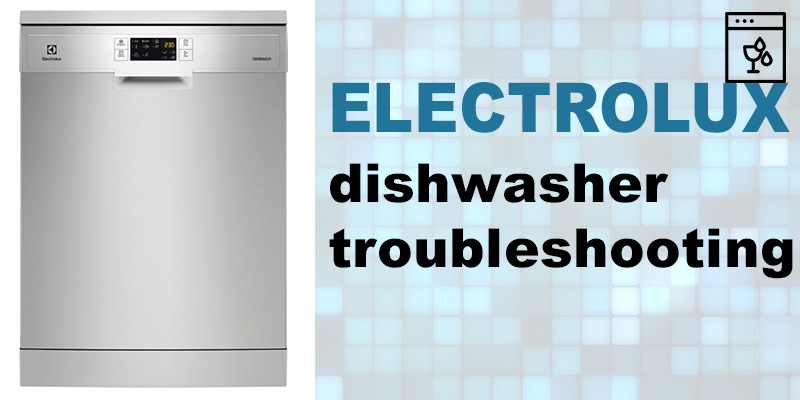
The Electrolux production can be met even in Antarctica, at the first standing research station Concordia. Its inhabitants use various kitchen equipment and dishwashers of this make as well.
The difference in the price of the Electrolux products is conditioned only by presence or absence of additional functions. One of such valuable functions is Electrolux dishwasher troubleshooting.
Electrolux dishwasher troubleshooting is very helpful; it properly reveals a breakdown for the subsequent repairs.
Electrolux basic dishwasher troubleshooting
Electrolux U series dishwasher troubleshooting
Electrolux basic dishwasher troubleshooting
Even basic dishwashers produced by the Swedish multinational brand Electrolux boast such innovative features as SatelliteSpray Arm, Target Wash Zones, allowing to clean dishes of any size and shape, and Soft Grip Racks holding dishes in place for a thorough clean. The table below provides tips on troubleshooting most basic Electrolux dishwashers.
| Problem | Possible solution |
|---|---|
| The indicator of the set programme flashes continuously. The end indicator flashes 1 time intermittently. | The appliance does not fill with water. |
| The indicator of the set programme flashes continuously. The end indicator flashes 2 times intermittently. | The appliance does not drain the water. |
| The indicator of the set programme flashes continuously. The end indicator flashes 3 times intermittently. | The anti-flood device is on |
| You cannot activate the appliance. | Make sure that the mains plug is connected to the mains socket. Make sure that there is not a damaged fuse in the fuse box. |
| The programme does not start. | Make sure that the appliance door is closed. If the delay start is set, cancel the setting or wait for the end of the countdown. |
| The appliance does not fill with water. | Make sure that the water tap is open. Make sure that the pressure of the water supply is not too low. For this information, contact your local water authority. Make sure that the water tap is not clogged. Make sure that the filter in the inlet hose is not clogged. Make sure that the inlet hose has no kinks or bends. |
| The appliance does not drain the water. | Make sure that the sink spigot is not clogged Make sure that the drain hose has no kinks or bends. |
| The anti-flood device is on | Close the water tap and contact the Service |
| Whitish streaks or bluish layers on glasses and dishes | The released quantity of rinse aid is too much. Adjust the rinse aid selector to a lower position. The quantity of detergent is too much. |
| Stains and dry water drops on glasses and dishes | The released quantity of rinse aid is not sufficient. Adjust the rinse aid selector to a higher position. The quality of the detergent can be the cause. |
| Dishes are wet | The programme is without a drying phase or with a low temperature drying phase. The rinse aid dispenser is empty. The quality of the rinse aid can be the cause. |
Electrolux U series dishwasher troubleshooting
A typical dishwasher that is a part of the Electrolux U series has at least four programs (Rinse and Hold, Normal 65C, Normal 50C, and Quick Wash). They can be performed either in the full load or half load mode. Some models have Eco and PreWash programs. Most of the appliances are intended for 12 place settings including serving dishes.
| Malfunction | Possible Cause | Remedy |
|---|---|---|
| The drain pump in the dishwasher runs continuously - even with the appliance switched off | The anti-flood system has been triggered. | Close the tap, then unplug from the mains and contact customer service. |
| The programme does not start. | The door of the dishwasher is not closed properly. | Shut the door. |
| Mains plug is not plugged in. | Insert mains plug. | |
| House fuse in defective. | Replace fuse. | |
| In the case of dishwasher models with start delay timer: A start delay is selected. | Where dishes are to be washed immediately, for appliances - with multidisplay, set the delay start to 0. - without multidisplay, cancel the delay start timer. |
|
| Rust spots are visible in the washing compartment. | The washing compartment is made of corrosion-resistant stainless steel. Rust spots in the washing compartment are from particles from outside the appliance (rust particles from the water pipe, from pans, cutlery, etc.). Remove such spots with a commercially available stainless steel cleaner. | Only wash cutlery and dishes that are suitable for dishwasher use. Close the lid of the special salt container securely |
| There is a whistling noise during washing. | The whistling is not a cause for concern. | Use a different brand of detergent. |
| The dishes are still dirty. | The wrong wash programme was selected. • The dishes were arranged in such a manner that water has not reached all parts. The dish racks must not be overloaded. • The filter in the base of the washing compartment is dirty or incorrectly positioned. • Detergent was not used or too little was used. • In the case of scale deposits on the dishes: the special salt container is empty or the water softener is incorrectly adjusted. • The drain hose is incorrectly laid. | |
| The dishes are wet and dull | Rinse aid was not used. The rinse aid container is empty. | |
| There are streaks, milky spots or a bluish coating on glasses and dishes. | Decrease rinse aid dosing. | |
| There are dried water drops on the glasses and dishes. | Increase rinse aid dosing. The detergent may be the cause. Contact the detergent manufacturer's consumer advisor. |
